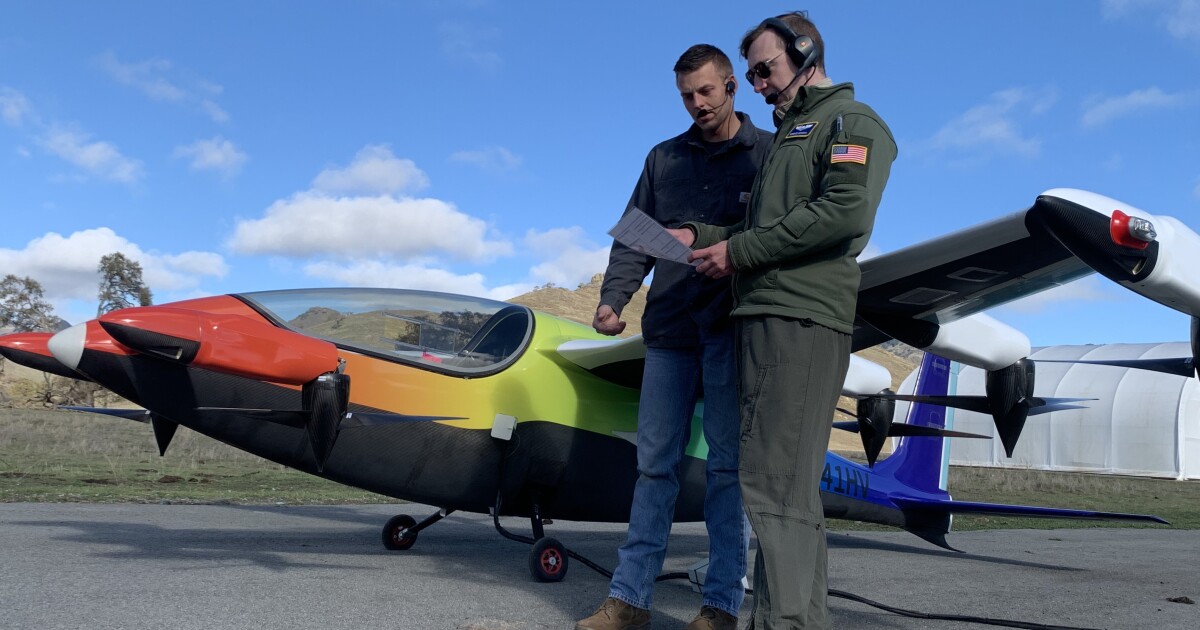Parker Downey (left) of Kitty Hawk and Terrance McKenna
USAF
The US Air Force's AFWERX technology accelerator program has announced that in December 2021 it successfully completed the first flight of an electric Vertical Takeoff and Landing (eVTOL) aircraft with an Air Force pilot at the remote controls.
Initiated in 2017, AFWERX's purpose is to find ways to encourage technical innovation in private companies by circumventing the conventional bureaucracy through the use of military contracts that not only focus on the technology itself, but also on factors like its infrastructure, certification, inter-agency relationships, and early operational uses.
The Heaviside being controlled by the Buddy Box
USAF
The purpose of the flights wasn't just to score a first for the record books. They were the result of a four-day training program on remotely controlling the Heaviside using the aircraft's Buddy Box, which is designed to act much like the special motor cars used in driver's education, where the student controls the vehicle, but the instructor retains primary control and can override any vehicle commands by the student.
Through such exercises, the hope is to familiarize Air Force personnel with the Heaviside, and also to improve both the aircraft and training methods. This is especially important because many of the eVTOL designs being developed aren't exactly in line with US FAA regulations, which often makes it difficult to get them certified.
Named for the English engineer, physicist, and mathematician Oliver Heaviside, the Heaviside eVTOL is a two-seater electric plane with a reverse-sweep wing with six tilting electric motor props and a small canard with two.
AFWERK Prime and AETC/DET62 team with the Heaviside
USAF
When aligned to thrust downwards, these propulsors allow the aircraft to lift off vertically or from a short runway. It can reach speeds of about 180 mph (290 km/h) and has a range of 100 miles (160 km) on one battery charge. It has a maximum takeoff weight of 880 lb (400 kg), allowing for two passengers weighing in at 176 lb (80 kg) each. One notable feature is that the aircraft is very quiet, putting out only 35 decibels at an altitude of 1,500 ft (460 m). That's about 100 times quieter than a conventional helicopter.
According to the Air Force, the system's Ground Control Station allows the Heaviside to be programmed with a complete flight plan, which it can carry out autonomously, though it can also be flown remotely as needed using the Buddy Box.
"It’s a different paradigm for operating the aircraft," said McKenna. "A crucial thing that the RC controller allows you to do that a completely unmanned or a completely ground-controlled station based approach does not is [gain] that intuition about the flight characteristics of the aircraft that are so important [for operational employment]."
Once fully developed, the Heaviside and similar vehicles could find military and civilian applications that include transporting casualties, evacuations from hostile territories, delivering cargo, providing first aid and medical services, and helping with fire fighting as well as search and rescue missions in remote areas.

USAF makes first eVTOL flight remotely controlled by an Air Force pilot
The US Air Force's AFWERX technology accelerator program has announced that in December 2021 it successfully completed the first flight of an electric Vertical Takeoff and Landing (eVTOL) aircraft with an Air Force pilot at the remote controls.


